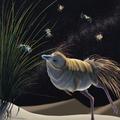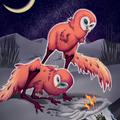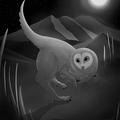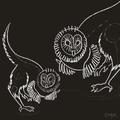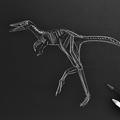Dinosaurs that hunted in the dark
Scientists discover that the small, desert-living dinosaur, Shuvuuia, had extraordinary vision and owl-like hearing for nocturnal life in the Cretaceous of Mongolia
- The dinosaur’s region of the inner ear responsible for hearing was almost identical to today’s barn owl, suggesting that Shuvuuia could have hunted in complete darkness, something that was unknown in any dinosaur
- Shuvuuia and its close relatives had some of the largest pupils yet measured on a dinosaur
- These findings suggest that Shuvuuia would have been an expert night-time hunter
- This is the first solid evidence of nocturnal specialization in dinosaurs
A new study published today, led by University of Oxford researchers Dr James Neenan and Professor Roger Benson, and Professor Jonah Choiniere from the University of the Witwatersrand in South Africa has revealed striking information about the similarities in the vision and hearing abilities of dinosaurs and birds. It is the first study to examine two sensory systems at the same time, vision and hearing, in extinct animals. The research has identified one extinct Mongolian dinosaur inhabitant as having particularly enhanced sensory skills for nocturnal life, and this is the first dinosaur to be found to have these attributes.
The international team of researchers used cutting-edge CT scanning and 3D reconstruction methods, along with detailed measurements to collect information on the relative size of the eyes and inner ears of over 100 living birds compared with those of extinct dinosaur species. It showed that a desert-living dinosaur, Shuvuuia, stood out as having exceptional hearing and night vision.
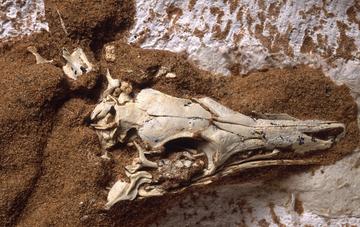
Photograph of fossilized Shuvuuia deserti skeleton by Mick Ellison - American Museum of Natural History
Of the thousands of bird species globally, only a few have adaptations enabling them to hunt active prey in the
dark of night. Scientists have long wondered whether theropod dinosaurs, the group that gave rise to modern birds, had similar sensory adaptations.
To determine the hearing capability of the dinosaur specimens, the team measured the length of the lagena, the organ of the inner ear that processes incoming sound information (called the cochlea in mammals) and compared them to modern birds, the dinosaurs’ living relatives. The barn owl, which can hunt in complete darkness using hearing alone, has the proportionally longest lagena of any bird.
To assess the vision of the dinosaur specimens, the team looked at the scleral ring, a series of bones surrounding the pupil, of each species. Like a camera lens, the larger the pupil can open, the more light can get in, enabling better vision at night. By measuring the diameter of the ring, the scientists could tell how much light the eye can gather.
The team found that many carnivorous theropods such as tyrannosaurs and Dromaeosaurus had vision optimized for the daytime, and better-than-average hearing presumably to help them hunt.
However, it was a diminutive theropod named Shuvuuia, part of a group known as alvarezsaurs, which stood out as having both extraordinary hearing and night vision. The extremely large lagena of this species is almost identical in relative size to today’s barn owl, suggesting that Shuvuuia could have hunted in complete darkness.
The eyes of Shuvuuia were also exceptional, as they had some of the proportionally largest pupils yet measured in either birds or dinosaurs, suggesting that Shuvuuia could likely see very well at night.
Shuvuuia was a small dinosaur, about the size of a chicken, and it lived in the Cretaceous deserts of what is now Mongolia. Shuvuuia’s skeleton is among the most bizarre of all dinosaurs – it has a fragile, bird-like skull, brawny, weightlifter arms with a single claw on each hand, and long, roadrunner- like legs. This odd combination of features has baffled scientists since its discovery in the 1990s. With the new data on Shuvuuia’s sight and hearing, the scientific team hypothesizes that like many desert animals, Shuvuuia would have foraged at night, using its hearing and vision to find prey, such as small mammals and insects, using its long legs to rapidly run that prey down, and using its strong forelimbs to pry the prey out of burrows or shrubby vegetation.
“Nocturnal activity, digging ability, and long hind limbs are all features of animals that live in deserts today, but it’s surprising to see them all combined in a single dinosaur species that lived more than 65 million years ago.” Said Professor Jonah Choiniere.
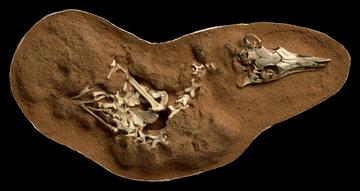
The large lagena of Shuvuuia came as a surprise discovery to Dr James Neenan, the joint first author of the study. “As I was digitally reconstructing the Shuvuuia skull, I could not believe the lagena size, so I called Prof. Choiniere to have a look. We both thought it might be a mistake, so I processed the other ear – only then did we realise what a cool discovery we had on our hands!” said Neenan.
“We’ve never been able to show such amazing sensory specialization in any dinosaur. What is even more amazing is that Shuvuuia evolved this ear first – millions of years before owls appeared! So, you could even say that Shuvuuia is the original owl (but they aren’t closely-related – owls evolved from another group of dinosaurs).”
“It’s also special because barn owls have always been held up as an amazing example of ultra-specialized hearing, since they can hunt with complete accuracy in 100% darkness, using hearing alone. So, when I discovered this crazy ear in Shuvuuia, I immediately knew it was something completely unique in dinosaurs. This advances the field because it is actual evidence that dinosaurs inhabited not only a range of different habitats, but also could be specialized to different times of day/night. This is the first solid evidence of nocturnal specialization in dinosaurs, so it increases our understanding that these animals really could evolve to do almost anything (a lot like modern birds and mammals).” said Neenan.
Header image credit: Shuvuuia deserti artist's reconstructions by Viktor Radermacher




